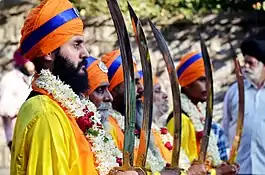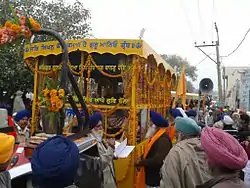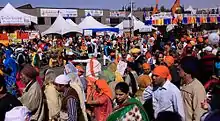Nagar Kirtan
Nagar Kirtan (Sanskrit: नगर कीर्तन, Bengali: নগর কীর্তন, Gurmukhi: ਨਗਰ ਕੀਰ੍ਤਨ) is a Hindu and a Sikh custom involving the processional singing of holy hymns throughout a community.[1]

Nagar Kirtan
Notable Hindu Saint Chaitnaya Mahaprabhu is credited with introduction of custom of Nagar Kirtan which included singing not only lyrical verses dedicated to Lord Krishna but also chanting and singing them repetitively on the streets of city in form of a procession.[2] Nagar Kirtan is an essentially a Vaishnava idea.[3] Chaitnaya propogated ideas of Bhakti through Samkirtan (collective recitation of the hymn) and Nagar Kirtan (Kirtan in form of religious processions).[4] The congregational singing of Chaitanya in the forms of Sankirtan and Nagar Kirtan always remained wrapped in the folk tunes of the devotees amidst the boisterous booming of drums and cymbals.[5]
Nagar Kirtan, in Sikhism, is customary in the festival of Vaisakhi. Traditionally, the procession is led by the saffron-robed Panj Piare (the five beloved of the Guru), who are followed by the Guru Granth Sahib, the holy Sikh scripture, which is placed on a float.[6] Commonly, members of the procession are unshod in deference to the displayed scripture. Likewise, many cover their heads and don the colour saffron or orange. The road before the procession is cleared by Sewadars. Bystanders bow their heads to the scripture. Food may be provided to them from floats that follow the Scripture or from stationary points near the vicinity of the procession.[7] The procession concludes at the Gurudwara with Ardas (pray).[8]

Gallery
.JPG.webp) Nagar Kirtan from Jarg to Rara Sahib
Nagar Kirtan from Jarg to Rara Sahib Nagar Kirtan floats arriving at Vaisakhi
Nagar Kirtan floats arriving at Vaisakhi Nagar Kirtan at Thathi Bhai
Nagar Kirtan at Thathi Bhai Nagar kirtan in Canada with kids practicing Gatka amongst crowd
Nagar kirtan in Canada with kids practicing Gatka amongst crowd
See also
References
- Dash Mesh,kirtan 15 September 2013
- Bhatia, Varuni (2017). Unforgetting Chaitanya: Vaishnavism and Cultures of Devotion in Colonial Bengal. Oxford University Press. ISBN 978-0-19-068624-6.
- Damen, Frans L. (1983). Crisis and Religious Renewal in the Brahmo Samaj, 1860-1884: A Documentary Study of the Emergence of the "New Dispensation" Under Keshab Chandra Sen. Department Oriëntalistiek, Katholieke Universiteit Leuven. ISBN 978-90-70192-12-9.
- Mallik, Basanta Kumar (1996). Medieval Orissa: Literature, Society, Economy, Circa 1500-1600 A.D. Mayur Publications.
- Current Thoughts on Sikhism. Institute of Sikh Studies. 1996. ISBN 978-81-85815-01-5.
- Nagar Kirtan 16 June 2012
- seke, 2014
- seke, 2014